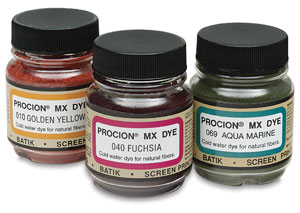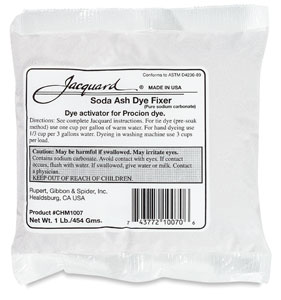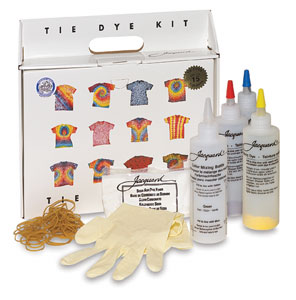Questions about dyeing knitted garments made of cotton
Name: Sherry

cool water dyes will not melt your wax
Procion dyes are permanent, colorfast, and very washable. You can easily create a palette of brilliant colors ranging from light pastels to deep, vibrant hues. Perfect for natural plant fibers - cotton, linen, paper, reeds, and wood.
Buy from Blick

Jacquard Soda Ash
Soda ash, or sodium carbonate, is the dye fixer used with Procion MX dyes. Procion dyes with soda ash create a strong permanent chemical bond with the cotton, so they simply do not wash out. Soda ash will not work with all-purpose dye such as Rit.
Buy from Blick
and help support this web site
Jacquard Tie Dye Kit

Dye up to 15 adult-size T-shirts, with vivid, electric colors that are so colorfast they can be washed with the daily laundry. Procion MX Fiber Reactive Dyes are already pre-measured for you in squeeze bottles. Just add water. Use on non-synthetic fabric.
Buy from Blick
and help support this web site
Country or region: USA
Message: I am interested in using the "drip dyes" method. I am a machine knitter and would like to dye my cotton garments to resemble tie dye. When using this method how do I finish the garment out after i "batch" it? Do I wait one day to help set colors so they won't bleed together [I sell at craft shows] and then wash first in cold, once, then twice in the hottest water available, using Synthrapol in each wash, and end by double-rinsing as you state elsewhere. I'm just unsure how to finish off as I haven't used dyes much at all. Thank you, I appreciate your time on this matter.
Hi Sherry,
The one thing I am not quite sure of, from your email, is whether you are planning to use the correct dyes. You cannot use this method with all-purpose dyes, such as Rit. You do appear to have a good understanding of the method, if you are planning to use Procion type fiber reactive dyes. You can buy these dyes by mail-order in many different individual colors, or you can buy a good tie-dyeing kit. I particularly like the kits made by Jacquard Products, but most brands of tie-dye kits will work fine.
My mother, Jan Burch, is a machine knitter; she advises that your yarn, or garments you have made with the yarn, must be washed before you attempt to dye them. The yarn has been treated with some sort of silicone surface treatment, which may repel the dye, resulting in poor dye uptake or in unwanted splotches. Wash the garment as usual in warm water before you attempt to dye it.
It looks like you have an excellent idea of what is required for washing out the excess unattached dye after letting the dye react. Be sure the room where you do your "batching" (allowing the dye to react with the fiber) is warm enough for the dye reaction, at least seventy degrees Fahrenheit. The knitted yarn must remain at least slightly moist for the dye reaction to occur, either by covering it with plastic, or by including urea (a humectant) in your dye mixtures.
To be sure whether you have washed out all of the excess dye, you can do a hot press test. See my page, "How can I test whether the dye will run?".
Since your yarn is made of cotton, you can finish your garments, after the washing process is complete, simply by ironing, to get them shaped right, instead of having to use a steamer as you would with some yarns, such as acrylic, so there's no problem with doing a hot press test on your knitted garments.
Paula
The one thing I am not quite sure of, from your email, is whether you are planning to use the correct dyes. You cannot use this method with all-purpose dyes, such as Rit. You do appear to have a good understanding of the method, if you are planning to use Procion type fiber reactive dyes. You can buy these dyes by mail-order in many different individual colors, or you can buy a good tie-dyeing kit. I particularly like the kits made by Jacquard Products, but most brands of tie-dye kits will work fine.
My mother, Jan Burch, is a machine knitter; she advises that your yarn, or garments you have made with the yarn, must be washed before you attempt to dye them. The yarn has been treated with some sort of silicone surface treatment, which may repel the dye, resulting in poor dye uptake or in unwanted splotches. Wash the garment as usual in warm water before you attempt to dye it.
It looks like you have an excellent idea of what is required for washing out the excess unattached dye after letting the dye react. Be sure the room where you do your "batching" (allowing the dye to react with the fiber) is warm enough for the dye reaction, at least seventy degrees Fahrenheit. The knitted yarn must remain at least slightly moist for the dye reaction to occur, either by covering it with plastic, or by including urea (a humectant) in your dye mixtures.
To be sure whether you have washed out all of the excess dye, you can do a hot press test. See my page, "How can I test whether the dye will run?".
Since your yarn is made of cotton, you can finish your garments, after the washing process is complete, simply by ironing, to get them shaped right, instead of having to use a steamer as you would with some yarns, such as acrylic, so there's no problem with doing a hot press test on your knitted garments.
Paula
Thank you so much, Paula for getting back to me on this.
Actually, I think I lost myself on the finish process. Is this how I do it:
1. Batch the piece.
2. wait one day to set colors
3. wash in cold water
4. wash in hot water, twice with Synthrapol...BUT is the rinsing in warm or cold??
5. now do a double rinse in...cold?? I will be giving this a try in a month or so, I have too many projects going on at the moment, but, am very excited about trying this out. I've also, been thinking of trying the method where you dropped out dye on the kids T's. I'll be experimenting for sure.! Ha! A lot of fun ahead. Have a great day and thank you, again for your time. I appreciate your help and please tell you Mother thank you for her input on this. ;-)
Sherry
Actually, I think I lost myself on the finish process. Is this how I do it:
1. Batch the piece.
2. wait one day to set colors
3. wash in cold water
4. wash in hot water, twice with Synthrapol...BUT is the rinsing in warm or cold??
5. now do a double rinse in...cold?? I will be giving this a try in a month or so, I have too many projects going on at the moment, but, am very excited about trying this out. I've also, been thinking of trying the method where you dropped out dye on the kids T's. I'll be experimenting for sure.! Ha! A lot of fun ahead. Have a great day and thank you, again for your time. I appreciate your help and please tell you Mother thank you for her input on this. ;-)
Sherry
The timeline for dyeing cotton with Procion MX dye is just as you wrote, but maybe it is not clear why.
For the dye to react with the fiber, you need to apply both the Procion dye and the soda ash fixative at the same time (either putting the dye on first and the soda ash second, or putting the soda ash first and the dye second). The soda ash activates the cotton so it can react with the dye. Note that soda ash does not help all-purpose dye, such as Rit dye, fix to the yarn; you should avoid using all-purpose dyes. Fiber reactive dyes such as Procion MX perform much better and last many times longer.
It takes some time for all of the reactions between dye molecules and cotton molecules to take place, and the reactions need to be a certain temperature for it to work, so you set your yarn or garment aside, while it is still wet with the dye and soda ash. Leaving it overnight in a warm place (70 degrees Fahrenheit or warmer) allows time for the reaction to take place. This time is, obscurely, referred to as "batching", for reasons having to do with industrial dyeing techniques that need not concern us.
Once all of the dye reactions have occurred, which is to say, the next day (or the day after that if it is more convenient for you), you want to rinse out the soda ash and some of the dye, by washing once in cool water. Either room temperature or cold water is fine for this step. You don't need to use any detergent for this first wash, but it does not hurt to use Synthrapol. I like to throw the dyed material into the washing machine for this, but you can rinse in a bucket, with many changes of water, if you prefer.
Finally, you need to wash out all of the unattached excess dye. To do this, it works best to use really hot water, 140 degrees Fahrenheit or hotter. Hotter is even better. Use a small amount of Synthrapol or other detergent, and repeat the hot water wash several times. No need to pay any attention to rinsing until you have done this washing two or three times. If the washing machine proceeds to a cold rinse before you are done with the hot washing, it won't do any good, but it also won't do any harm, aside from a minor waste of water.
After all of your washing is done, rinse to remove the Synthrapol or other detergent. The washing machine rinse is fine for this. It does not matter what temperature your rinse water is, since it is pretty easy to rinse out detergent. Cold, warm or hot will all do fine. If you can still smell the detergent after one rinse, do another one.
If you are not sure whether you have gotten out all of the unattached excess dye, do the hot press test that I linked to before. This test should be done for any yarn or fabric that is going to be sold, or used together in a multi-colored piece.
There are many fun dye application techniques that can be done with the above basic method. It's such an enjoyable thing to experiment with.
Paula
For the dye to react with the fiber, you need to apply both the Procion dye and the soda ash fixative at the same time (either putting the dye on first and the soda ash second, or putting the soda ash first and the dye second). The soda ash activates the cotton so it can react with the dye. Note that soda ash does not help all-purpose dye, such as Rit dye, fix to the yarn; you should avoid using all-purpose dyes. Fiber reactive dyes such as Procion MX perform much better and last many times longer.
It takes some time for all of the reactions between dye molecules and cotton molecules to take place, and the reactions need to be a certain temperature for it to work, so you set your yarn or garment aside, while it is still wet with the dye and soda ash. Leaving it overnight in a warm place (70 degrees Fahrenheit or warmer) allows time for the reaction to take place. This time is, obscurely, referred to as "batching", for reasons having to do with industrial dyeing techniques that need not concern us.
Once all of the dye reactions have occurred, which is to say, the next day (or the day after that if it is more convenient for you), you want to rinse out the soda ash and some of the dye, by washing once in cool water. Either room temperature or cold water is fine for this step. You don't need to use any detergent for this first wash, but it does not hurt to use Synthrapol. I like to throw the dyed material into the washing machine for this, but you can rinse in a bucket, with many changes of water, if you prefer.
Finally, you need to wash out all of the unattached excess dye. To do this, it works best to use really hot water, 140 degrees Fahrenheit or hotter. Hotter is even better. Use a small amount of Synthrapol or other detergent, and repeat the hot water wash several times. No need to pay any attention to rinsing until you have done this washing two or three times. If the washing machine proceeds to a cold rinse before you are done with the hot washing, it won't do any good, but it also won't do any harm, aside from a minor waste of water.
After all of your washing is done, rinse to remove the Synthrapol or other detergent. The washing machine rinse is fine for this. It does not matter what temperature your rinse water is, since it is pretty easy to rinse out detergent. Cold, warm or hot will all do fine. If you can still smell the detergent after one rinse, do another one.
If you are not sure whether you have gotten out all of the unattached excess dye, do the hot press test that I linked to before. This test should be done for any yarn or fabric that is going to be sold, or used together in a multi-colored piece.
There are many fun dye application techniques that can be done with the above basic method. It's such an enjoyable thing to experiment with.
Paula
(Please help support this web site. Thank you.)
Posted: Friday - March 22, 2013 at 11:02 AM
Follow this blog on twitter here.
Quick Links
- All About Dyes & Dyeing Top -
- Top of this blog -
- FAQ -
- The Dye Forum -
- How to Tie Dye - How to Batik -
- Books - Toys - Plants -
- Top of this blog -
- FAQ -
- The Dye Forum -
- How to Tie Dye - How to Batik -
- Books - Toys - Plants -
More in this category:
- -
Statistics
Total entries in this blog:
Total entries in this category:
Published On: Mar 25, 2013 07:58 AM
Total entries in this category:
Published On: Mar 25, 2013 07:58 AM